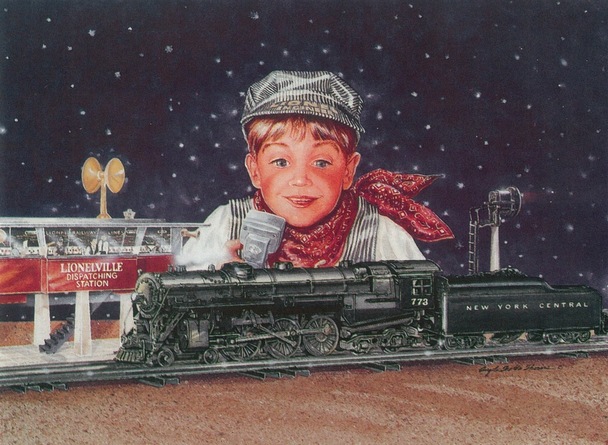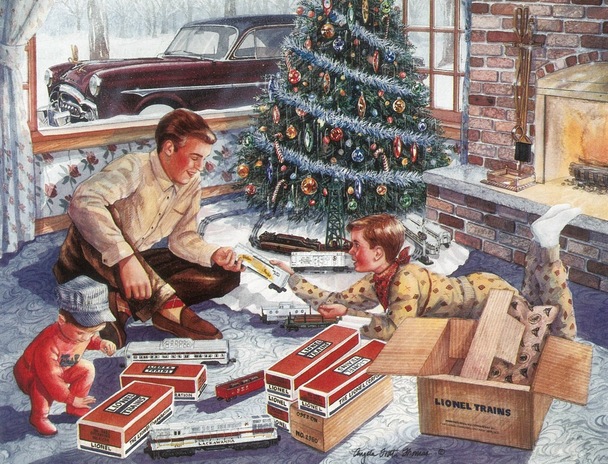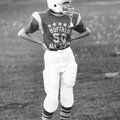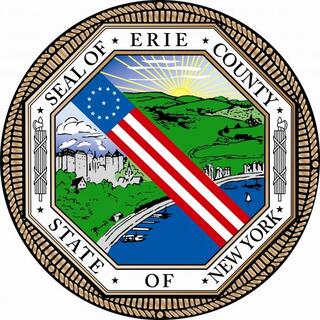Robert Schuh, the owner of K-Val Hobbies, must have shared his love of model trains with hundreds of Western New York people over the years. We asked him to tell us about his career working on the (model) railroad.
All my life I have loved trains. I received my first train for Christmas in 1929 – a Lionel 248 with a 427 and 430 in red. Each year around October, I would look in the paper for the ten cent coupon to send for a Lionel train catalog, and then watch eagerly for the mailman. When I finally received my catalog, I would go through every page, dreaming about all the trains I wished I could have. Unfortunately, during the big depression my dad was just about making ends meet. But somehow my parents had managed to give me my first train.
As I got older, I started to buy my own trains. I remember a 238 E Torpedo, a bullet-shaped stream-lined steam engine based on a revolutionary Raymond Loewy design, with three blue and silver passenger cars, including an observation deck. Then there was the blunt-nosed zephyr-type Commodore Vanderbilt 265E with freight cars. I built my first layout up in our attic. My friends and I had a lot of enjoyment running that layout.
I got married while I was in the service, and after I was discharged, my wife and I moved into a flat on the East Side of Buffalo. The first Christmas we were there I bought my first complete train set: a 726 Berkshire set with four freight cars, modeled after the behemoth steam engine used on the Albany-Boston run over the Berkshire Mountains, made by Lionel in 1946. While I was away in the service, some of my trains had disappeared. Many items were missing, including that very first train, but I was able to find a replacement, which I have to this day.
Now that we were settled, I bought more trains. For about two years, I would put a layout up in the living room on a 4’x8’ board with houses and scenery. Then I was able to talk my wife into moving the furniture out of the dining room and putting up an L-shaped layout up off the floor. And I bought more trains, including a Lionel 622 Santa Fe switcher. Now the dining room was too small, so the next move was to the cellar. My next layout was L-shaped with a main section 25’x10’ with about 35’ running down along the wall with a large turn-around loop back to the main table. Then I started to add working accessories – a 497 coal loader, a 282 magnetic crane, a 364 log loader, and complete scenery. That set was a real ripper. Fortunately, the house was owned by my dad, so we could build what we wanted there!
By this time, I had started to raise a family – a daughter and a son. When my son was four, I thought it was time for his own train set. I bought him a 682 Turbine engine set with four cars and built him a small layout which would fold down over his bed when he wanted to use it. Then I built two nice new rooms in the attic as bedrooms for my children. I had also gotten into repainting Lionel trains for friends, so I built a work bench in my son’s room, which was the largest. Then, too, there was the 7’x9’ HO layout in that room.
My son was pleased with his big room, but it turned out he had his bed behind the workbench with the layout taking up most of the space. Little did I know that many years later, he too would happily be doing model train repairs.
Around that time, I was getting interested in HO trains. I remember buying an Athearn Santa Fe because of the colorful red and silver. I also remember liking the powerful New York Central Hudson steam engine; that was when I got my first kit. It was an International kit, and when I opened it I found it was a Santa Fe Hudson. At the time I thought all Hudsons were New York Central, but now I found that was not true. The hobby that had fascinated me since I was a kid was turning into something more involved.
In 1964 we bought a new house in Kenmore. I had to take down my Lionel layout and sell many of my Lionel trains, but I set up the HO in our new home. Now I was collecting Lionel O standard gauge trains, and repairing trains for hobby shops.
When some regular employees were on vacation, I got to work in Howard Ruth’s shop for six weeks. Then I began to repair trains for what was then Burt’s Hobby on Delaware Avenue in Kenmore. I also worked at Frankie’s Hobby Shop, owned by Frank Larango, until it closed. When Howard Ruth moved out to Kenmore (almost across the street from Frankie’s), I worked there until he closed in 1972. Then I decided to start my own hobby shop.
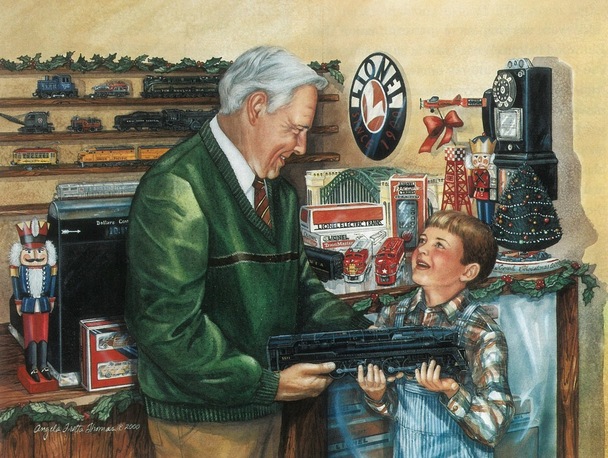
“The Legend Continues – Thanks Grandpa” Lionel Catalog cover art courtesy of the artist, Angela Trotta Thomas.
I was working as a pattern maker for Elmwood Pattern Works, which, at the time, was run by my father and my uncle, and the trains came with me. I took over a rear room which was about 30’x15’ and remodeled it. I continued to work in the pattern works, running the hobby shop at the same time, until the 1980s when I purchased the building, moved out the machinery and took over the whole thing for trains. This was the shop that became known as K-Val Hobbies.
Meanwhile, back at home, I had built my second HO layout and had a nice Lionel O and Standard collection. I wasn’t satisfied with this layout, so I had to take over the cellar again. I started from scratch to build what is now a nice operational layout. Since we had to have a place for the laundry, I built an addition on the house. I had a father and his two sons who used to come on Tuesday nights to run the layout when the boys were only four and six years old. Today at 13 and 15, they can run any part of the layout – with their Dad. And we have a 10’x10’ layout which I put up specially at Christmastime to run my Lionel O and Standard.
We have four layouts in the store which we run for kids young and old. We also use them as teaching tools to show people how they can build their own layouts. A hobby like model railroading teaches kids to use their hands to build things, something which is becoming rare today. They learn to plan, and they create what they see in their imaginations. They also learn about electricity. After all, if it were not for a man like Joshua Lionel Cowen experimenting with batteries and electricity, we would not have electric trains today.
Model railroading started a hundred years ago, in 1901, and is still going strong. As you might imagine, there have been many advances in model trains recently, with all the electronics, simulation of real sounds, remote control and trains that are exact replicas of the real thing. I feel I have been very fortunate to be able to turn a hobby into a business and enjoy it. It’s still a tradition to have a train running around the Christmas tree – and I would like to think that in the years to come this tradition will be carried on.
How It All Began
In 1901, a 24-year-old inventor, Joshua Lionel Cowen, was experimenting with electricity. He had invented a battery-operated portable fan, and a portable hand-held lamp. The fan was a flop, and the lamp (which he discarded) eventually became the Eveready flashlight. In 1901 he created a window display for a toy store. He put a wooden cheese box on little battery-operated wheels that ran on rails. It was a gimmick to attract attention to the toy display. It succeeded, but people wanted to buy the electric device itself. Within a year the company he decided to call Lionel trains began its phenomenal marketing success, capturing the imaginations of successive generations of fathers and sons, and for a long time becoming as much a part of the winter holiday scene as the Christmas tree itself.
Through the 50s and 60s it was a Christmas tradition to visit the elaborate train layout at Erie County Savings Bank on Shelton Square. That building was demolished, but the tradition lives on at the Buffalo and Erie County Historical Society (25 Nottingham Court, 873-9644). Children of all ages are still fascinated by this miniature railroad world, as is evident from the enthusiasm of visitors asking “Is the train man here?” Historical society volunteers will be on hand to run the model train layout beginning on November 23.
